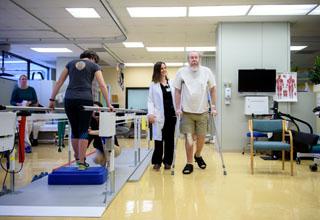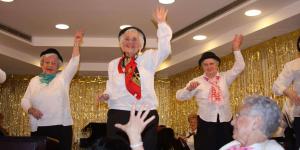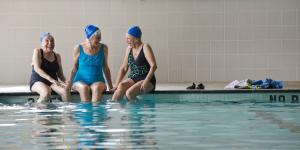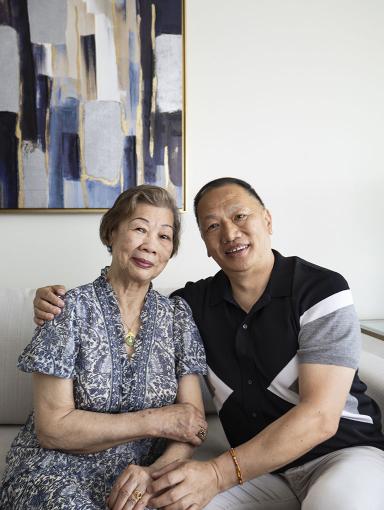How to Manage Arthritis for Older Adults
Tips and exercises for easing pain and stiffness

Arthritis is a painful and debilitating condition prevalent among older adults. Based on adjusted estimates, 92.1 million adults in the United States either have doctor-diagnosed arthritis or report joint symptoms consistent with a diagnosis of arthritis.
In addition to the chronic pain associated with arthritis, the condition has a profound effect on quality of life for older adults.
What is arthritis?
Arthritis is a generalized term for joint disease that causes swelling, pain, and stiffness. There are more than 100 types of arthritis. The most common form of arthritis is osteoarthritis, often referred to as OA or “wear and tear” arthritis. Women are two times more at risk than men.
In its severe form, arthritis can cause functional disability, loss of joint motion and overall strength, sleep disturbance, and depression. Osteoarthritis is a chronic condition that can affect any joint, but it occurs most often in knees, hips, lower back, neck, small joints of fingers, and at the bases of thumbs and big toes. There is currently no cure, but there are treatments.
What causes osteoarthritis?
We don’t fully understand the cause of osteoarthritis, but it is prevalent in people who have been injured or who regularly engaged in sports or leisure activities that involved repetitive use of joints.
Joints have a lining of cartilage for protection that forms a slippery non-friction surface, cushioning, and lubrication to ease joint movements. Osteoarthritis develops when this lining breaks down over time resulting in bone spurs, tears, and eventually worn away areas that cause bone to rub against bone.
Advanced age, obesity, genetics, gender, bone density, trauma, and a poor level of physical activity can lead to the onset and progression of osteoarthritis.
Arthritis is diagnosed by clinical signs of joint pain, swelling, loss of range of motion, and by x-ray or magnetic resonance imaging (MRI) to identify degenerative changes in joints, including loss of joint space, bone spurs, and cartilage damage.
The impact of arthritis in older adults
Arthritis can impact an individual’s ability to perform basic activities of daily living such as showering, dressing, and managing mobility. Often, individuals with chronic arthritis have difficulty getting up from chairs, getting in and out of bed, walking, and sometimes even standing.
Pain has a significant negative effect on daily life and is a major complaint that brings patients to physical therapy. Many people with osteoarthritis say the pain, fatigue, disfigurement, and mobility limitations of the disease lead to social isolation, which may impact relationships. Many of my patients report sleep disturbances that lead to poor concentration and depression. Joint deformity that can result from osteoarthritis often requires use of a brace or devices such as a cane or walker, which can cause loss of self confidence and self-esteem and may make some people feel embarrassed.
Arthritis can also limit a person’s ability to walk distances or for the length of time necessary to engage in activities like travel, visiting museums, and simply getting around in their community. Individuals with arthritis often feel unsteady and are at higher risk for injury from events such as a fall.
And finally, osteoarthritis is linked to increased rates of comorbidity, including obesity, diabetes, and heart disease.
The promise of research
Research is ongoing to better understand the underlying causes of arthritis, including osteoarthritis, with an eye toward prevention and improved treatment options. One of the foremost researchers investigating osteoarthritis in the United States is Marian T. Hannan, DSc, MPH, a senior scientist at the Hinda and Arthur Marcus Institute for Aging Research at Hebrew SeniorLife and professor of medicine at Harvard Medical School. Dr. Hannan is currently conducting research on risk factors for arthritis, foot disorders and biomechanics, hip fracture, and osteoporosis. She is particularly interested in the effect of biomechanics upon physical function and the influence of body composition. She is widely published, with her work represented in many scientific journals in the medical field. Read Dr. Hannon’s blog about Arthritis and Foot Health to learn what causes arthritis in feet and what you can do about foot pain.
Tips for managing osteoarthritis
Strategies you can use to manage osteoarthritis include:
• Protect joints in hands and arms by using a device to reach for objects, adaptive equipment designed to assist with opening cans, negotiating zippers, and fastening buttons, and padded and larger grip handles.
• Take pressure off hip, knee, and ankle joints with good supportive shoes, and use a cane or walker to get around.
• Avoid stairs when possible.
• Avoid sitting for extended periods (no more than one hour at a time).
• Use a chair with arms, a raised toilet, and a shower chair to take stress off leg joints.
• Avoid high repetition of squatting, bending, or kneeling.
• Use long-handled cleaning devices or a reacher to pick up objects from the floor.
• Pace yourself when performing daily activities.
• Avoid painful movements as much as possible to help maintain function.
Patients are also treated with pain medications and anti-inflammatory medicines (NSAIDS). Cortisone injections in joints can help bring temporary relief. End stage disease requires total joint replacements.
Exercise is the best treatment
Physical therapy and exercises are the most important and effective treatment for osteoarthritis.
Many people who come to physical therapy are looking to improve their ability to join in activities with family and friends. They often want to improve their walking tolerance so they can participate in a family wedding or travel.
I’ve had patients who’ve been able to go on lifetime dream trips after receiving physical therapy. Others have been able to set aside their walker in favor of a cane. With joint replacement and physical therapy, some have been able to progress off devices they used for years.
Osteoarthritis can be managed at home with exercises and the use of heating pads and ice packs.
Best exercises for arthritis
Low impact exercises, such as walking, biking, and swimming and other water activities, help to motivate people and keep them moving. Running, jogging, jumping rope, high impact aerobics, or any other exercise where both feet are off the ground at the same time should be avoided.
Here are some exercises that I recommend to my patients to ease the discomfort of osteoarthritis.
For knee pain:
- Sit and kick knee out straight and hold with squeeze of thigh muscle for 10 seconds.
- Sit and bend knee as far as you are able under your seat and hold 10 seconds--repeat 10 times.
For hip pain:
- Stand while holding on to a solid support (chair or countertop) and march in place, lifting your leg as high as you can and alternating legs.
- Stand while holding on to a solid support and swing leg out to side while keeping knees straight; repeat 10 times with each leg.
To strengthen ankles:
- Hold on to a support and raise heels as high as possible. Hold for 10 seconds and repeat 10 times.
To strengthen and stretch legs:
- Stand facing the wall. Place hands on the wall with one leg back behind keeping your heel on the ground until you feel the stretch in your calf muscle. Hold for 10 seconds.
For upper body pain:
- Shoulder rolls help ease upper body discomfort. Rotate shoulders back and then squeeze shoulder blades together. Repeat 10 times.
- Stand with a slight bend forward. Hang your hand and arm down toward the floor and rotate your arm in gentle circles called pendulums. Circle 10 times.
What should I do if I think I have arthritis?
If you suspect that you have arthritis, you should consult your primary care physician. They can provide treatment and/or refer you to a specialist and other care professionals, such as physical therapists.
Hebrew SeniorLife specializes in adult physical therapy using state-of-the art mobility and treatment equipment, including manual therapy, joint mobilization, and therapeutic modalities to maximize function and independence. Outpatient physical therapy services are available at Hebrew Rehabilitation Center in Boston and Dedham. Our services are open to all residents of Boston and surrounding communities.
Visit our website to learn more.
Blog Topics
Learn More
Outpatient Rehabilitative Therapies
At Hebrew Rehabilitation Center in Boston and Dedham, MA, we offer adult physical therapy, occupational therapy, and speech therapy using state-of-the-art mobility and treatment equipment.





